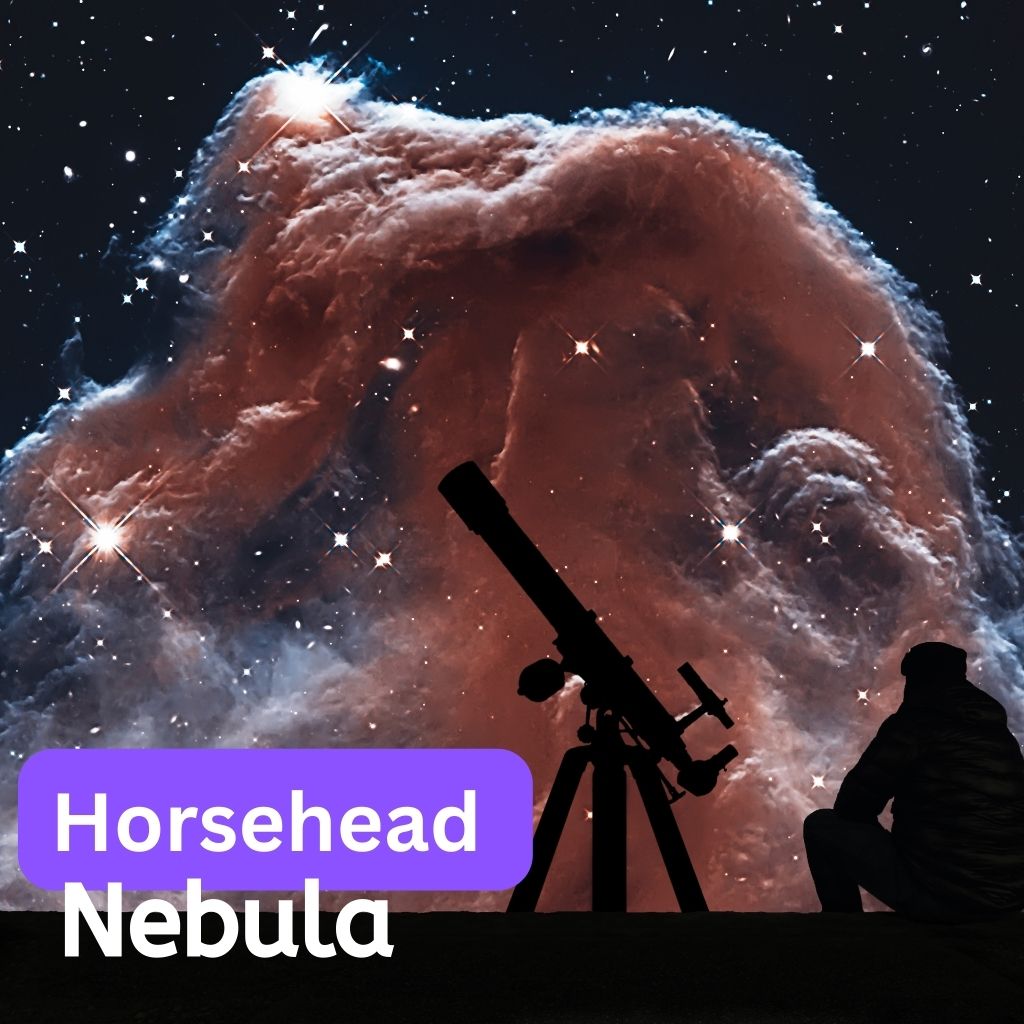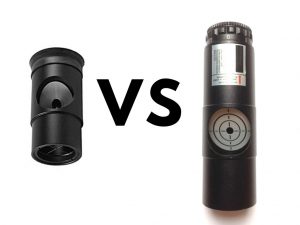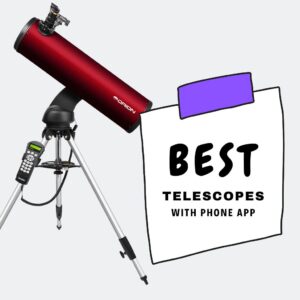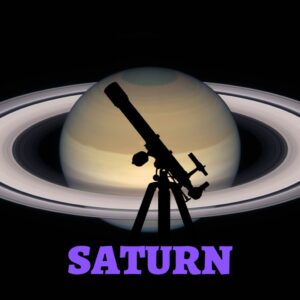This site contains affiliate links to products. I may receive a commission for purchases made through these links.
The Horsehead Nebula, also called Barnard 33, is a faint and dark nebula, making it a challenging target for observation. A telescope with an aperture of at least 8 inches is recommended to view the Horsehead Nebula, but this may also depend on the observing conditions and the observer’s experience.
While smaller telescopes can still provide enjoyable views of the Moon, planets, and brighter objects, they may not have enough light-gathering power to reveal the details of fainter objects like galaxies, nebulas, and star clusters.
The Horsehead Nebula sits in close proximity to the bright star Alnitak in Orion’s belt and its nearby companion, the Flame Nebula.
This article will explore the best telescope options for observing this fascinating celestial object.
Can I observe the Horsehead Nebula without a telescope?

The Horsehead Nebula cannot be seen with the naked eye. It requires a telescope or binoculars to observe. The observation of the Horsehead Nebula also requires a clear, dark sky and preferably a viewing location away from light pollution.
It is also recommended to use a low-magnification eyepiece to increase the field of view and allow for a better appreciation of the nebula’s surroundings.
Can I observe the Horsehead Nebula with a small telescope?
You can observe the Horsehead Nebula with a small telescope, but it will be very faint and difficult to see. A larger telescope with a wider aperture will provide better views.
This dark nebula is relatively faint and requires dark skies with minimal light pollution to be visible. A small telescope with a narrow aperture may not allow enough light to enter, making the nebula even more difficult to see.
A small telescope may not have a high enough magnification to reveal the intricate details of the nebula. Therefore, a larger telescope with a wider aperture will be better suited for viewing the Horsehead Nebula.
5 best telescope sizes for observing Horsehead Nebula
To get the best views of the Horsehead Nebula, it is crucial to use a telescope with an appropriate size and aperture.
Here are the best telescope sizes for observing the Horsehead Nebula:
1. 8-inch aperture
An 8-inch aperture telescope is an excellent choice for observing the Horsehead Nebula. With an aperture of 8 inches, this telescope can gather enough light to provide detailed and clear views of the nebula.
This size of the telescope strikes a good balance between portability and power.
Let’s examine some specific models of 8-inch aperture telescopes that are well-suited for observing the Horsehead Nebula.
Celestron NexStar 8SE Telescope
The Celestron NexStar 8SE is a powerful and easy-to-use telescope that is perfect for viewing the Horsehead Nebula. With its 8-inch aperture, the telescope possesses good light-gathering capabilities, making faint objects like the Horsehead Nebula visible.
The NexStar 8SE is also equipped with a computerized GoTo mount, which allows users to easily locate and track celestial objects, including the Horsehead Nebula.
The telescope is compact and easy to transport, making it a great choice for both backyard and travel stargazing.
You may also: Celestron NexStar 8SE Telescope Review (Read Before Purchase)
Orion SkyQuest XT8 Plus Dobsonian Telescope
The Orion SkyQuest XT8 Plus is a classic Dobsonian telescope that is great for observing the Horsehead Nebula. The telescope features a sturdy wooden base and a smooth, precise focuser that makes it easy to adjust the view of the nebula.
The SkyQuest XT8 Plus also comes with several accessories, including a 2-inch Crayford-style focuser, a 28mm DeepView eyepiece, and a collimation cap, all of which help enhance the viewing experience.
Celestron Advanced VX 8″ EdgeHD Telescope
Celestron Advanced VX 8″ EdgeHD Telescope combines an 8-inch EdgeHD optical tube with Celestron’s Advanced VX mount, which features advanced tracking and alignment capabilities.
The EdgeHD optical system delivers sharp, clear views of the Horsehead Nebula and other deep-sky objects, while the sturdy mount ensures smooth and accurate tracking.
The Celestron Advanced VX 8″ EdgeHD Telescope also includes a StarPointer Pro finderscope and a 1.25-inch star diagonal.
2. 10-inch aperture telescope
A 10-inch aperture telescope is a popular option for stargazing enthusiasts due to its impressive light-gathering capabilities and relatively compact size.
With its larger aperture compared to smaller telescopes, it can capture more light and provide brighter, clearer views of celestial objects.
This makes it great for observing faint objects such as the Horsehead Nebula.
Let’s explore some of the best 10-inch aperture telescopes for viewing Horsehead Nebula
Sky-Watcher Classic 250 Dobsonian 10-inch aperture telescope
The Sky-Watcher Dobsonian 10 is a powerful telescope with a 10-inch aperture that provides impressive views of the Horsehead Nebula and other deep-sky objects.
Its large aperture and long focal length produce sharp, detailed images with excellent contrast and color rendition.
The Dobsonian mount provides stability and ease of use, while the included 25mm and 10mm eyepieces offer different magnifications for versatile observing.
This telescope features a two-speed Crayford-style focuser for precise focusing and a red-dot finder for locating objects in the sky.
You may also like: Top 3 Sky-Watcher 10-inch Dobsonian Telescopes
Orion SkyQuest XT10i IntelliScope
Orion SkyQuest XT10i IntelliScope is a Dobsonian-style telescope with a 10-inch parabolic primary mirror and is equipped with Orion’s IntelliScope computerized object locator system, which guides you to over 14,000 celestial objects.
The telescope also features a solid, stable base and smooth, easy-to-use altazimuth mount.
The XT10i’s large aperture and user-friendly design make it a great choice for observing the Horsehead Nebula and other deep-sky objects.
The Celestron–StarSense Explorer 10-inch Dobsonian Smartphone App-Enabled Telescope
The Celestron–StarSense Explorer 10-inch Dobsonian Smartphone App-Enabled Telescope is an excellent choice for those interested in exploring the night sky, including the Horsehead Nebula.
This telescope features a 10-inch aperture, which allows for great light gathering capabilities and provides clear and crisp views of deep-space objects. The Dobsonian mount makes it easy to use, as it allows for smooth and precise movements of the telescope.
One of the most unique features of this telescope is its compatibility with the StarSense Explorer app, which is available for both iOS and Android devices.
The app will guide you to the Horsehead Nebula and other deep space objects, and it will even help you align your telescope for accurate tracking.
3. 12-inch aperture telescope
A 12-inch aperture telescope is a significant upgrade from smaller telescopes, offering a greater light-gathering capacity and resolving power.
This makes it suitable for deep sky objects like the Horsehead Nebula, as well as for planetary observation.
With a 12-inch telescope, you can expect to see greater detail and clarity in your observations.
Here are some of the best 12-inch telescopes for observing the Horsehead Nebula.
Meade Instruments LightBridge Plus 12
Meade Instruments LightBridge Plus 12 offers a 12-inch aperture and a focal length of 1524mm. Its large aperture allows for exceptional light-gathering capabilities, and the fast focal ratio of f/5 makes it great for deep sky observation.
It also has a sturdy truss tube design that allows for easy transport and assembly. With its excellent optical performance, the Meade Instruments LightBridge Plus 12 is a great option for viewing the Horsehead Nebula.
Sky-Watcher Flextube 300 Dobsonian 12-inch telescope
The Sky-Watcher Flextube 300 Dobsonian Telescope is a great option for those looking for a powerful and portable telescope with a 12-inch aperture.
Its collapsible design allows for easy transportation and storage, making it a convenient option for stargazing on-the-go. The 12-inch aperture provides excellent light-gathering ability, allowing for clear views of faint deep-sky objects such as the Horsehead Nebula.
The telescope comes with a sturdy Dobsonian mount which provides smooth and stable tracking for celestial objects. The mount allows for easy movement and adjustments, making it simple for beginners to use.
4. 14-inch aperture telescope
The Horsehead Nebula is a faint object, and a larger telescope, like the 14-inch aperture telescope, can capture more light, making it easier to see.
With a 14-inch aperture telescope, you can observe the intricate details of the nebula, including the distinctive shape of the Horsehead, which can be missed with smaller telescopes.
Here are the best 14-inch telescope options for observing this Dark Nebula
Meade 14-Inch LX200-ACF (f/10) OTA Telescope
The Meade LX200-ACF 14″ is a powerful telescope that is designed for serious astronomers. It features a 14-inch aperture and a maximum magnification of 700x, making it ideal for viewing the Horsehead Nebula and other faint deep-sky objects.
This telescope also includes Meade’s Advanced Coma-Free (ACF) optics, which provide excellent image quality and reduce image distortion.
The Meade LX200-ACF 14″ is a high-end telescope designed for experienced astronomers looking for the best possible viewing experience.
5. 16-inch aperture telescope
A 16-inch aperture telescope is a powerful instrument that can capture impressive views of deep-space objects. It allows for greater light-gathering capability, making it ideal for observing faint objects like the Horsehead Nebula.
Here are some of the best 16-inch aperture telescopes that are great for viewing this iconic nebula and other deep sky objects.
Explore Scientific 16-inch Truss Tube Dobsonian Telescope
The Explore Scientific 16-inch Truss Tube Dobsonian Telescope is a great option for advanced astronomers who are looking for a large aperture telescope.
Its 16-inch aperture allows for excellent light-gathering capabilities, making it suitable for observing faint celestial objects like the Horsehead Nebula.
The telescope’s truss tube design allows for easy transport and storage, making it a great choice for those who want a large telescope but don’t want to sacrifice portability. T
The Explore Scientific 16-inch Truss Tube Dobsonian Telescope also comes with a 2-inch focuser and a 9×50 finderscope, providing users with a great viewing experience.
Meade 16-Inch LightBridge Truss-Tube Dobsonian
The Meade 16-Inch LightBridge Truss-Tube Dobsonian is a powerful telescope that is ideal for observing deep-sky objects such as the Horsehead Nebula.
It features a large 16-inch aperture and a fast f/4.5 focal ratio, which makes it highly effective at gathering light and providing clear, detailed views of celestial objects.
The truss-tube design of the telescope makes it easy to transport and set up, despite its large size.
Accessories for observing Horsehead Nebula
When it comes to observing celestial objects like the Horsehead Nebula, having the right accessories can enhance your viewing experience.
Here are some of the best accessories that can help you observe the Horsehead Nebula and other deep-sky objects with greater clarity and precision.
H-beta filter
A hydrogen beta filter can help enhance the nebula’s contrast against the background sky. This is because the filter blocks out other wavelengths of light and only allows the specific wavelength emitted by hydrogen gas to pass through.
Using a filter can make the nebula appear more distinct and easier to observe.
One good brand for a hydrogen-beta (H-beta) filter is the Astromania 2″ Narrowband H-Beta Filter. This is a high-quality filter designed for astrophotography enthusiasts. If you want an image of the Horsehead Nebula captured in clear detail, you need this filter.
This filter effectively blocks out all wavelengths of light except for the H-beta spectral line, which is responsible for the signature red hue of this nebula.
Mount
Using a mount is important when observing the Horsehead Nebula, or any deep-sky object, as it helps stabilize the telescope and keep it pointed at the object.
Deep-sky objects like the Horsehead Nebula are faint and require a long exposure time to capture enough light to see them clearly.
Any slight movement or vibration can ruin the image. A stable mount with a smooth and precise tracking system can help prevent this from happening and ensure a crisp and clear view of the object.
A good mount such as the Sky-Watcher EQ6-R Pro can also enhance the overall observing experience by reducing eye strain and fatigue from manually holding the telescope steady for an extended period.
This mount features advanced tracking capabilities, allowing for precise and smooth tracking of celestial objects like the Horsehead Nebula.
Celestron Advanced VX Mount is another good choice. This versatile and portable mount can support up to 30 pounds of telescope equipment. It features advanced GoTo technology that can automatically locate and track celestial objects.
You may also like: Sky-Watcher Mounts (All Models)
Observing chair
A comfortable observing chair or stool can be a helpful tool to make observing more comfortable, especially during longer observing sessions.
This can reduce fatigue and strain on the neck and back, allowing you to observe for longer periods of time and potentially see more detail in the nebula.
The Starbound Astronomy Viewing Chair has a sturdy construction and a durable finish that ensures long-lasting use.
The padded seat is filled with a resilient material that won’t rot or decay in hot or cold conditions. It can be adjusted to different heights and has a wide reach to provide comfort while using a variety of telescope eyepieces.
The chair can fold into a compact and flat profile for easy storage and transportation. Its lateral stability prevents it from tipping over when an observer leans left or right.
FAQs
Let’s address some of the most commonly asked questions about observing the Nebula.
Can I view the Horsehead Nebula with a 10-inch telescope?
You can view the Horsehead Nebula with a 10-inch telescope. However, the viewing conditions must be ideal, and you will need to use a narrowband filter to enhance the contrast and make the nebula visible.
The Horsehead Nebula is a faint object, so you will need to observe from a dark site with minimal light pollution to have the best chance of seeing it.
What size of telescope do you need to see a nebula?
A telescope with an aperture of at least 6 inches is recommended for observing nebulae, but larger telescopes can provide better views and more details.
Generally, the telescope size you need to see a nebula depends on several factors, including the size and brightness of the nebula, the amount of light pollution in your area, and your observing skills.
Additionally, the use of filters and other accessories can enhance the visibility of nebulae and improve the observing experience.
Takeaway: Catch a glimpse of the Horsehead Nebula with these tools, perfect for observing the wonders of the dark nebula
The Horsehead Nebula is a striking example of a dark nebula located within the constellation Orion. It is part of the Orion Molecular Cloud Complex, a vast region of interstellar gas and dust that gives birth to new stars.
Observing the Horsehead Nebula requires a telescope with a large aperture and high magnification. While it may be visible with smaller telescopes, a telescope with at least an 8-inch aperture is recommended for optimal viewing.
You should also include important accessories such as a telescope mount, a Hydrogen beta filter, and an observing chair.
Remember to always check the weather conditions and light pollution levels before attempting to view the Horsehead Nebula.
You may also like:














